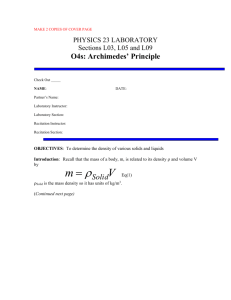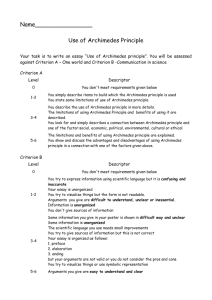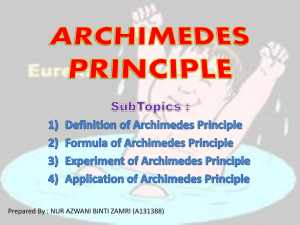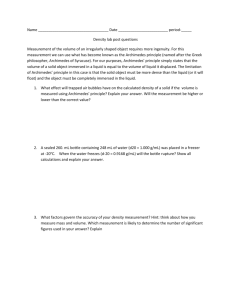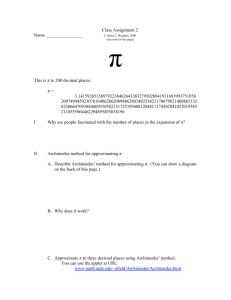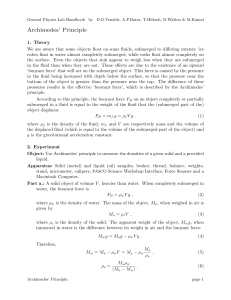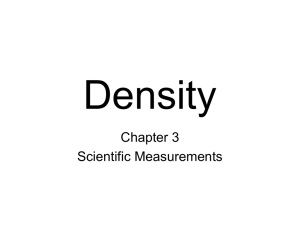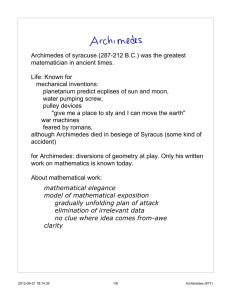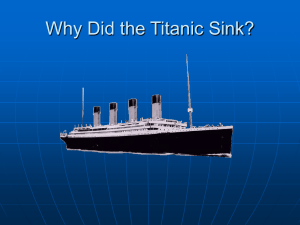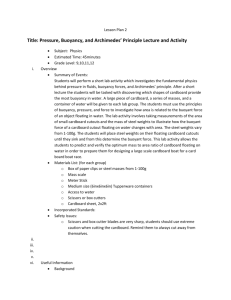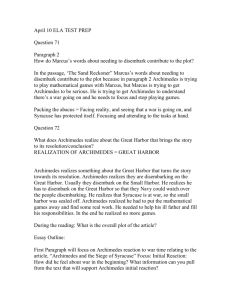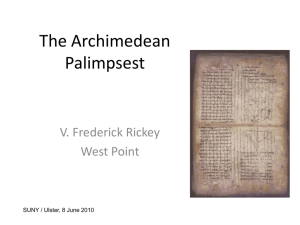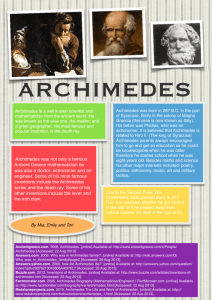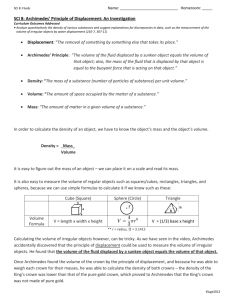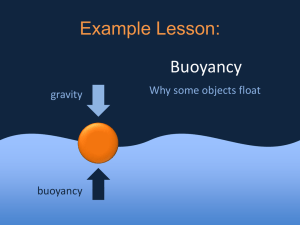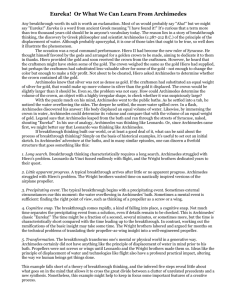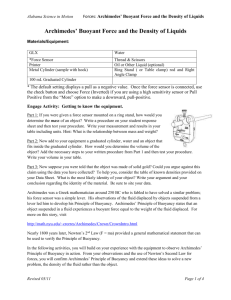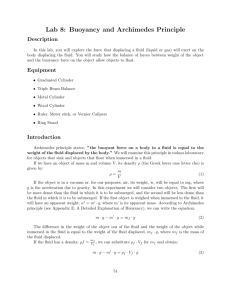Aashia Bajwa Final project
advertisement
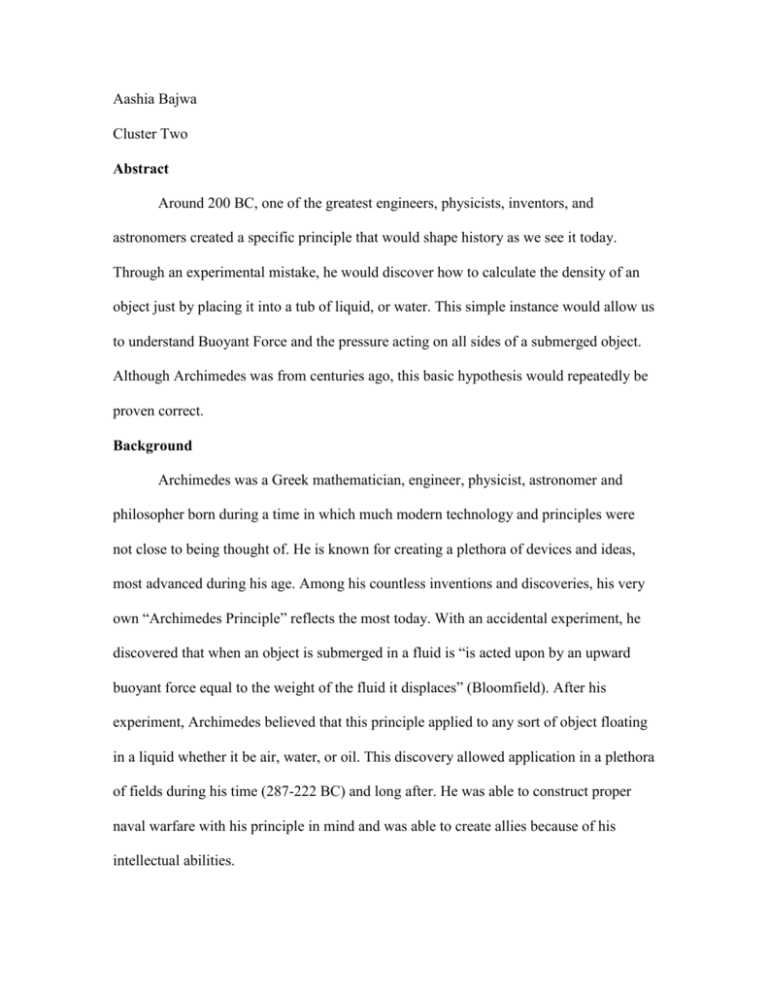
Aashia Bajwa Cluster Two Abstract Around 200 BC, one of the greatest engineers, physicists, inventors, and astronomers created a specific principle that would shape history as we see it today. Through an experimental mistake, he would discover how to calculate the density of an object just by placing it into a tub of liquid, or water. This simple instance would allow us to understand Buoyant Force and the pressure acting on all sides of a submerged object. Although Archimedes was from centuries ago, this basic hypothesis would repeatedly be proven correct. Background Archimedes was a Greek mathematician, engineer, physicist, astronomer and philosopher born during a time in which much modern technology and principles were not close to being thought of. He is known for creating a plethora of devices and ideas, most advanced during his age. Among his countless inventions and discoveries, his very own “Archimedes Principle” reflects the most today. With an accidental experiment, he discovered that when an object is submerged in a fluid is “is acted upon by an upward buoyant force equal to the weight of the fluid it displaces” (Bloomfield). After his experiment, Archimedes believed that this principle applied to any sort of object floating in a liquid whether it be air, water, or oil. This discovery allowed application in a plethora of fields during his time (287-222 BC) and long after. He was able to construct proper naval warfare with his principle in mind and was able to create allies because of his intellectual abilities. Experimental Procedure Like most scientists, Archimedes did not initially set out to discover a law about buoyancy in fluids. It is said that he often did work for Hiero, the king of Syracuse, and that one day, Hiero asked Archimedes to determine if a gold crown was truly gold, or if it was replaced it with a fake material. That day Archimedes was taking a bath and realized that when he stepped inside, a certain amount of water came out of the tub. This form of displacement helped him decipher a way to determine whether or not the gold crown was truly gold (Holt). Although Archimedes did not have a set experiment, it is simple to realize his speculations with modern knowledge. For instance, if you were to submerge a cube in any liquid, there would be pressure acting above and under the cube. You could calculate the Net force of the cube by subtracting the bottom by the top because the deeper you go in depth in water, the higher the pressure. Then, you would derive a formula that would fundamentally mean that the Volume of the object would be equal to the Volume of the liquid it displaces. Results Archimedes discovered that “when a body is immersed in a fluid at rest, the total force acting on it by the fluid is - ഽഽ p dS where dS is a vector element of area directed outward from the body. But ഽഽ p dS= ഽഽഽ grad p dV. Therefore =ഽ ഽ p dS + ഽഽഽ pg dV =0. The resultant force on the immersed body is equal and opposite to the total weight of the displaced fluid” (Corden 3). This holds for compressible fluids such as water and can even be used to calculate specific gravity according to Corden. Archimedes created this principle that would be used for centuries later when modern day ships and vessels would be built. His principle applies to “objects floating or submerged in any fluid, including air, water, or oil. The buoyant force originates in the forces a fluid exerts on the surfaces of an object” (Bloomfield). Impact The Archimedes Principle is found in a plethora of common things in the status quo. We often use his laws of buoyancy in order to ensure for safety and resilience for many ships and vessels. “This has remained the physical basis for judging the floating ability and stability of ships in design and operations” (Nowacki). Works Cited “Buoyancy: Archimedes Principle.” Buoyancy: Archimedes Principle. 1 Aug. 2015. “Archimedes Biography.”-Childhood, Life Achieements & Timeline. Web. 17 July 2015. “Archimedes-Hellenisistic Mathematics-The Story of Mathematics.” Web. 1 Aug. 2015 Corden, Harris. “Handbook of Physics”. 1 Aug. 2015. Bloomfield, Louis. “How Things Work: The Physics of Everyday Life”. 1 Aug. 2015.
